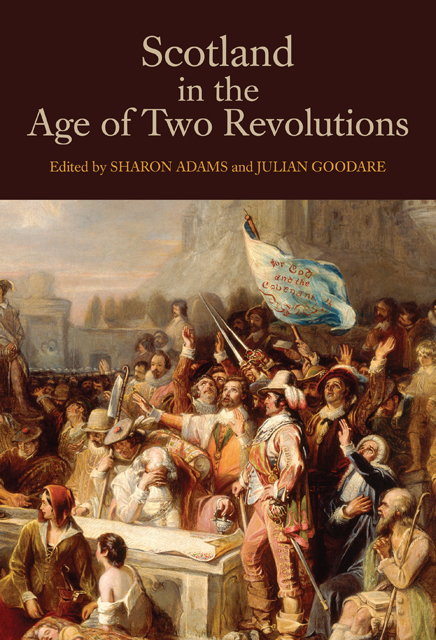Book contents
- Frontmatter
- Dedication
- Contents
- Figures and Tables
- List of Contributors
- Preface
- List of Abbreviations
- 1 Scotland and its Seventeenth-Century Revolutions
- 2 The Middle Shires Divided: Tensions at the Heart of Anglo-Scottish Union
- 3 The Western Highlands and Isles and Central Government, 1616–1645
- 4 The Scottish Bishops in Government, 1625–1638
- 5 The Scottish Revolution
- 6 In Search of the Scottish Republic
- 7 Highland Lawlessness and the Cromwellian Regime
- 8 The Worcester Veterans and the Restoration Regime in Scotland
- 9 The Political Thought of the Restoration Covenanters
- 10 Scottish State Oaths and the Revolution of 1688–1690
- 11 The Tribulations of Everyday Government in Williamite Scotland
- 12 The Company of Scotland and Scottish Politics, 1696–1701
- Chronology of Seventeenth-Century Scotland
- Further Reading
- Index
- Studies in Early Modern Cultural, Political and Social History
6 - In Search of the Scottish Republic
Published online by Cambridge University Press: 28 February 2023
- Frontmatter
- Dedication
- Contents
- Figures and Tables
- List of Contributors
- Preface
- List of Abbreviations
- 1 Scotland and its Seventeenth-Century Revolutions
- 2 The Middle Shires Divided: Tensions at the Heart of Anglo-Scottish Union
- 3 The Western Highlands and Isles and Central Government, 1616–1645
- 4 The Scottish Bishops in Government, 1625–1638
- 5 The Scottish Revolution
- 6 In Search of the Scottish Republic
- 7 Highland Lawlessness and the Cromwellian Regime
- 8 The Worcester Veterans and the Restoration Regime in Scotland
- 9 The Political Thought of the Restoration Covenanters
- 10 Scottish State Oaths and the Revolution of 1688–1690
- 11 The Tribulations of Everyday Government in Williamite Scotland
- 12 The Company of Scotland and Scottish Politics, 1696–1701
- Chronology of Seventeenth-Century Scotland
- Further Reading
- Index
- Studies in Early Modern Cultural, Political and Social History
Summary
And I may confidently say, That God’s controversie with the Kings of the Earth; is for their Arbitrary and Tyrannical Government.
On 30 January 1649, Charles I stepped out of the window of the Banqueting House of the Palace of Whitehall onto the scaffold on which his execution would take place, an event that brought to an end ‘One Act of our lamentable Tragedy’. Notoriously, the Scots began the next act of their tragedy with the proclamation of his son, Charles II, not just as king of Scots, but as king of Great Britain and Ireland. This provoked an invasion of Scotland by Oliver Cromwell in the summer of 1650, which resulted in two humiliating Scottish defeats, first at Dunbar on 3 September 1650 and then, on 3 September 1651, at Worcester. The result was a decade of English military occupation and Scotland’s incorporation into what became the ‘Commonwealth of England, Scotland and Ireland’. Because English hostility to Charles I’s regime culminated in ‘republicanism’, it makes sense to ask whether Scottish hostility to Charles I’s regime might not also have had ‘republican’ tendencies. This also raises the question of what is meant by ‘republicanism’ in a seventeenth-century context. But before addressing these questions, some more discussion of that context is needed.
I
The Worcester campaign in 1651 was the fourth time since 1640 that a Scottish army had entered or invaded England. The first invasion had been during the second of the two Bishops’ Wars (1639 and 1640), which saw the Scottish rebellion against Charles I of 1637–38 transformed into a military conflict. The Scottish covenanting regime then allied itself with the English parliament against Charles I in the Solemn League and Covenant of 1643, as a result of which Scottish troops crossed the border again in January 1644. A Scottish army entered England for a third time, this time in an alliance with Charles, the Engagement of December 1647. This was the product of a counter-revolution in Scotland in which Scottish royalists made common cause with moderate members of the Scottish parliamentary regime. The defeat of the Army of the Engagement by Cromwell’s forces at Preston in 1648 allowed the radical wing of the covenanting movement, those who had refused to participate in the Engagement, to seize power. But it was this same radical regime that later proclaimed Charles II as king and negotiated his return to Scotland.
- Type
- Chapter
- Information
- Scotland in the Age of Two Revolutions , pp. 97 - 114Publisher: Boydell & BrewerPrint publication year: 2014



